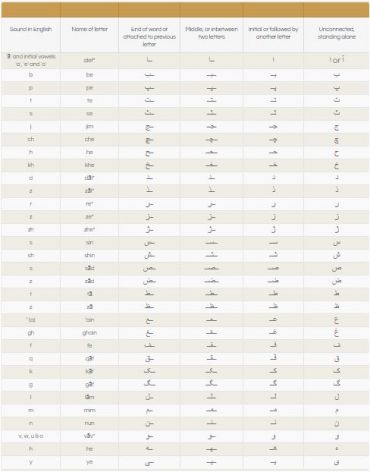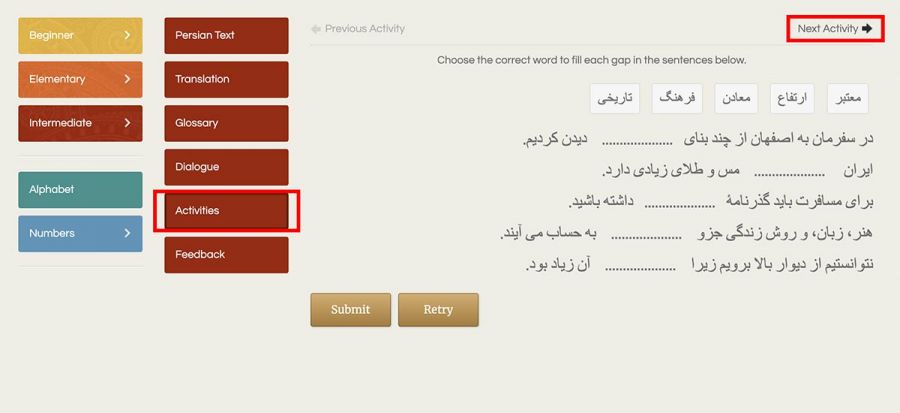
Project 6060 – Lesson 49
EN
FR
ES
FA
-
EN
Lesson 49
Iranian History in the Sasanian Period
***
Translation
About 2000 years ago, two superpowers existed in the world; that is, the Sassanian government and the Roman government. The border between these two countries was always changing because of war, but the Euphrates River was a natural border between these two governments. The Sassanian dynasty, which Ardeshir the First founded in the year 224 AD, governed Iran until the year 651 AD; that is, a period of 427 years. It is interesting that the Sassanian dynasty fell not by Rome, which was their extremely powerful enemy, but by the Arabs, who had recently formed an Islamic government.
The Sassanian era is one of the most important eras of Iranian history. They revived the Persian culture and the Zoroastrian religion. They traded with China, and even their greatest enemy; that is, the Romans. With searches and excavations that have been undertaken in China, gold and silver coins from the Sassanian era have been salvaged that had been under the earth for many centuries.
‘Ardeshir the First’ returned the strength of Persia to this land, which many years earlier, in the time of Darius the Third, the Achaemenid, was destroyed by Alexander. He seized many regions, including Armenia, in wars with the Romans and established a national government, based on Iranian culture.
‘Shapur the First’ came to power after the death of his father ‘Ardeshir’ and, in a war with the Romans, captured the Roman Emperor, ‘Valerin’. He also established ‘Gandi Shapur’, which was main educational centre and offered higher-level education.
Still not long had passed since the Sassanian Empire, when ‘Mani’, the founder of the Manichaeism religion, appeared. The new religion that he presented was a combination of ingredients from Zoroastrianism, Christianity and Buddhism. A little later he was tried and killed.
‘Shapur the Second’, who had lost his father before birth, was elected as King of Iran from the time of his birth. He was king of Iran for a long time and recaptured many of the lands that had been separated from Iran.
About one hundred years later, and during the reign of ‘Qobad the Sassanian’, ‘Mazdak’ revolted. Mazdak was a proponent of the abolition of private property and the distribution of wealth, and supported the avoidance of violence. His views brought about much social turmoil between the people and the aristocracy. Mazdak could be called the world’s first communist.
From the year 531 until 579, which was the climactic period of the dynasty of Sassanian Kings, ‘Khosrow the First’, the child of ‘Qobad the Sassanian’, whose title was ‘Anushirvan’, ruled over Iran. With the help of the elders, he killed Mazdak and his followers and put in place internal reforms and taxes and, because of this, they call him Anushirvan the fair or just. He paid much attention to the development of science and research and supported the translation of Greek and Indian medical and scientific texts into the Middle Persian language, or Pahlavi. In the time of Anushirvan, Gandi Shapur became one of the largest collections of books in the world of that day. He also supported philosophers who fled from the religious despotism of the Roman Empire and became refugees in Iran and gave them financial support. He was a King of the people and everybody could access him and every person could benefit from his fairness and have a formal meeting with the King. It is said that the game of backgammon was invented by his popular prime minister, ‘Bozorgmehr’.
‘Yazdegard the Third’ was the final Sassanian king. At that time, because of long wars between the Sassanians and the Romans and their continual defeats, Iran’s military power and economy was substantially reduced. At this same time, the Islamic religion came about in Saudi Arabia and spread. Muslim Arabs, who had united, attacked Iran and Rome and brought about a crushing defeat over the troops of Yazdegard the Third during The Battle of Qadisiyyah in the year 632AD. With the death of Yazdegard the Third in the year 651AD in Marv, the reign of the mighty and glorious Sassanian government also came to an end.
-
FR
Leçon 49
L’histoire iranienne à la période Sasanienne
***
Traduction
Coming soon
-
ES
Lección 49
Historia iraní en el período Sasánida
***
Traducción
Coming soon
-
FA
درس چهل و نهم
ایران
***
متن فارسی
حدود ۲۰۰۰ سال پیش، دو ابرقدرت یعنی دولتِ ساسانی و دولتِ روم در جهان وجود داشتند. مرز بینِ این دو کشور به علّت جنگ هایی که داشتند همواره تغییر می کرد، امّا رودِ فَرات مرزِ طبیعی میان این دو دولت بود. سلسلۀ ساسانیان که اردشیرِ اوّل آن را در سال ۲۲۴ میلادی بنیان گذاشته بود تا سال ۶۵۱ میلادی یعنی به مدّت ۴۲۷ سال بر ایران حکومت کرد. جالب است که سلسلۀ ساسانیان نه توسّط روم که دشمن بسیار نیرومندش بود بلکه توسّط عرب ها که به تازگی دولت اسلامی تشکیل داده بودند سقوط کرد.
دورۀ ساسانیان یکی از مهم ترین ادوار تاریخ ایران است. آنها فرهنگ پارسی و دین زرتشتی را دوباره زنده کردند. آنها با چینی ها و حتّی بزرگ ترین دشمنشان یعنی رومی ها تجارت می کردند. با كاوش ها و حفّاری هایی که در كشور چین انجام شده، سكّه های طلا و نقرۀ دورۀ ساسانیان که قرن های زیادی زیر خاک بوده، به دست آمده است.
“اردشیرِ اوّل” قدرت سرزمین پارس را که سال ها پیش در زمان داریوش سوّمِ هخامنشی به دست اسکندر از بین رفته بود به این سرزمین بازگرداند. او در جنگ با رومیان مناطق بسیاری از جمله ارمنستان را تصرّف کرد و یک حکومت ملّی بر پایۀ فرهنگ ایرانی بنا نهاد.
“شاپورِ اوّل” پس از مرگ پدرش، “اردشیر”، به سلطنت رسید و در جنگ با رومیان امپراتور روم “والرین” را اسیر كرد. او همچنین “گندی شاپور” را که یک مرکز مهم و عمدۀ آموزشی بود و دانشچویان را در سطح بالایی آموزش می داد ایجاد کرد.
هنوز چند سالی از پادشاهی ساسانیان نگذشته بود که “مانی”، پایه گذار مذهب مانوی ظهور کرد. مذهب جدیدی که او ارائه کرد تركیبی از عناصر زرتشتی، مسیحی و بودایی بود. او بعدها محاکمه و کشته شد.
“شاپورِ دوّم” که قبل از تولّد، پدرش را از دست داده بود از زمان تولّد به عنوان پادشاه ایران برگزیده شد. او مدّت زیادی پادشاه ایران بود و بسیاری از سرزمین هایی را که از ایران جدا شده بود دوباره تصرّف کرد.
حدود صد سال بعد و در زمان سلطنت “قباد ساسانی” “مزدک” انقلاب کرد. “مزدک” طرفدار لغو مالكیّت خصوصی و تقسیم ثروت بود و از دوری کردن از خشونت حمایت می کرد. نظرات او آشفتگی های اجتماعی بسیاری میان مردم و اشراف به وجود آورد. مزدک را شاید بتوان اوّلین كمونیست جهان نامید.
از سال ۵۳۱ تا ۵۷۹ “خسروِ اوّل” فرزند “قبادِ ساسانی” که لقبش “انوشیروان” بود بر ایران حکومت کرد که این دورۀ اوج پادشاهان سلسلۀ ساسانیان بود. وی به کمک بزرگان، مزدک و پیروانش را کشت و اصلاحات داخلی و مالیاتی انجام داد و به همین علّت به او انوشیروانِ عادل یا دادگر می گویند. وی به پیشرفت علم و تحقیق بسیار توجّه داشت و از ترجمۀ متن های پزشكی و علمی یونانی و هندی به زبان فارسی میانه یا پهلوی حمایت می كرد. در زمان انوشیروان كتابخانۀ گندی شاپور، یكی از بزرگ ترین مجموعه های كتاب در جهان آن روز شد. او همچنین از فلاسفه ای كه از استبداد مذهبی امپراتوری روم می گریختند و به ایران پناهنده می شدند حمایت می کرد و كمك مالی به آنها می کرد. وی پادشاهی مردمی بود و همه می توانستند به او دسترسی داشته باشند و هركسی می توانست از عدالت او بهره مند شود و با شاه ملاقات رسمی داشته باشد. گفته می شود كه بازی تخته نرد را نخست وزیر مشهور او “بزرگمهر”، ابداع كرد.
“یزدگردِ سوّم” آخرین پادشاه ساسانی بود. در آن زمان به علّت جنگ های طولانی بین ساسانیان و رومیان و شکست های پی در پی آنها، قدرت نظامی و اقتصادی ایران بسیار کاهش یافته بود. در همان زمان دین اسلام در عربستان پدیدار شد و گسترش یافت. عرب های مسلمان که متّحد شده بودند به ایران و روم حمله کردند و در جریان جنگ قادسیّه در سال ۶۳۲ میلادی شکست سختی بر سپاه یزدگردِ سوّم وارد آوردند. با مرگ یزدگردِ سوّم در سال ۶۵۱ میلادی در “مرو” حکومت مقتدر و شکوهمند دولت ساسانی نیز به پایان رسید.
DIALOGUE
DIALOGUE
DIÁLOGO
مُکالِمه
-
EN
Translation of Dialogue
Maryam: In your opinion, which Sassanian king was best?
Bahman: Anushirvan.
Maryam: Why?
Bahman: Well he was both just and he would help the people and he also paid attention to science and research. What’s your opinion?
Maryam: Well, I’m more interested in Shapur the Second.
Bahman: How come?
Maryam: Because with the defeat of the Romans he got back many of the cities again.
Bahman: That’s right. However the Sassanians were defeated by the Romans in many of the battles.
Maryam: Yeah, but these were the Arabs who pulled down the Sassanian Dynasty after Islam. -
FR
Traduction de Dialogue
Coming soon
-
ES
Traducción de Diálogo
Coming soon
-
FA
متن فارسی مُکالمه
مریم: به نظر تو کدوم پادشاه ساسانی بهتر بوده؟
بهمن: انوشیروان.
مریم: چرا؟
بهمن: خُب هم عادل بوده و به مردم کمک می کرده و هم به علم و تحقیق توجّه
داشته. از نظر تو چی؟
مریم: خُب، من به شاپورِ دوّم بیشتر علاقه دارم.
بهمن: چطور؟
مریم: چون با شکست رومیا خیلی از شهرها رُ دوباره پس گرفتن.
بهمن: درسته. البته ساسانیان تو خیلی از جنگا از رومیا شکست خوردن.
مریم: آره، امّا این عربا بودن که بعد از اسلام سلسلۀ ساسانیانُ از بین بردن.








